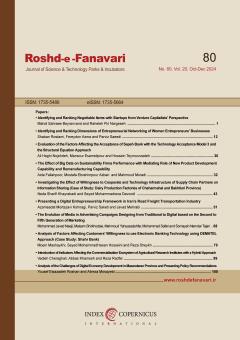Presenting a digital entrepreneurship framework in Iran's road freight transportation industry
Subject Areas : كارآفريني و مديريت شركتهاي دانش بنيان
Azam sadat Mortazavi kahangi
1
![]() ,
Parviz Saketi
2
,
Javad Mehrabi
3
,
Parviz Saketi
2
,
Javad Mehrabi
3
1 - Department of Entrepreneurship, Qazvin Branch, Islamic Azad University, Qazvin, Iran
2 - Department of Educational Management and Planning, Shiraz University, Iran
3 - Department of Public Administration, Qazvin Branch, Islamic Azad University, Qazvin, Iran
Keywords: Entrepreneurship, digital entrepreneurship, road freight industry, design science,
Abstract :
The present research uses the research method of design science with the aim of designing a digital entrepreneurship framework in Iran's road freight transportation industry. This research is fundamental-applied in terms of data type, mixed (qualitative-quantitative) in exploratory type; according to the time of data collection, it was cross-sectional and according to the method of data collection or the nature and method of the research, it was a survey. The statistical society of the qualitative part of the research included 20 experts and specialists in the field of digital entrepreneurship and related industry, who were selected using theoretical saturation. In the quantitative part, using Cochran's formula and cluster sampling method, 170 employees of relevant industry were selected as samples. Semi-structured interview and researcher-made questionnaire were used to collect data, and its validity and reliability were checked and confirmed. Coding and systematic review of literature and Maxqda software were used to analyze the data in the qualitative part. In the quantitative part, one-sample t-test and structural equation modeling and SPSS and Lisrel software were used. In order to evaluate and test, the designed framework was studied in a company in related industry. results showed that the components of digital entrepreneurship in Iran's road freight transportation industry include structural, technical and developmental components Also, the affecting factors, consequences, platforms, facilitators, obstacles and strategies were presented in this framework. Also, the results showed that the research model has a good fit and all the identified factors are in a higher than average condition.
